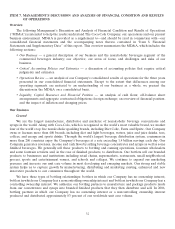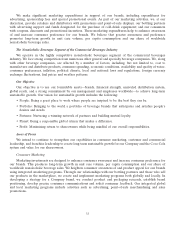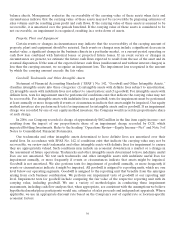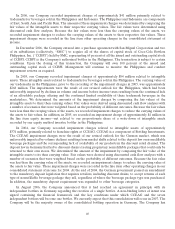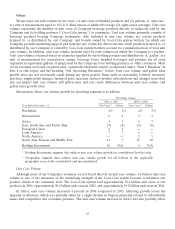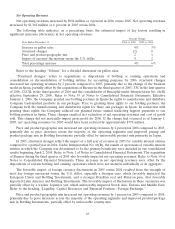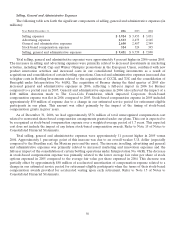Coca Cola 2006 Annual Report Download - page 44
Download and view the complete annual report
Please find page 44 of the 2006 Coca Cola annual report below. You can navigate through the pages in the report by either clicking on the pages listed below, or by using the keyword search tool below to find specific information within the annual report.bases of assets and liabilities. The tax rates used to determine deferred tax assets or liabilities are the enacted tax
rates in effect for the year in which the differences are expected to reverse. Based on the evaluation of all
available information, the Company recognizes future tax benefits, such as net operating loss carryforwards, to
the extent that realizing these benefits is considered more likely than not.
We evaluate our ability to realize the tax benefits associated with deferred tax assets by analyzing our
forecasted taxable income using both historical and projected future operating results, the reversal of existing
temporary differences, taxable income in prior carryback years (if permitted) and the availability of tax planning
strategies. A valuation allowance is required to be established unless management determines that it is more
likely than not that the Company will ultimately realize the tax benefit associated with a deferred tax asset.
Additionally, undistributed earnings of a subsidiary are accounted for as a temporary difference, except that
deferred tax liabilities are not recorded for undistributed earnings of a foreign subsidiary that are deemed to be
indefinitely reinvested in the foreign jurisdiction. The Company has formulated a specific plan for reinvestment
of undistributed earnings of its foreign subsidiaries which demonstrates that such earnings will be indefinitely
reinvested in the applicable tax jurisdictions. Should we change our plans, we would be required to record a
significant amount of deferred tax liabilities.
The American Jobs Creation Act of 2004 (the ‘‘Jobs Creation Act’’) was enacted in October 2004. Among
other things, it provided a one-time benefit related to foreign tax credits generated by equity investments in prior
years. In 2004, the Company recorded an income tax benefit of approximately $50 million as a result of this new
law. The Jobs Creation Act also included a temporary incentive for U.S. multinationals to repatriate foreign
earnings at an approximate 5.25 percent effective tax rate. During 2005, the Company repatriated approximately
$6.1 billion in previously unremitted foreign earnings, with an associated tax liability of approximately
$315 million. The reinvestment requirements of this repatriation are expected to be fulfilled by 2008 and are not
expected to require any material change in the nature, amount or timing of future expenditures from what was
otherwise expected. Refer to Note 1 and Note 17 of Notes to Consolidated Financial Statements.
The Company’s effective tax rate is expected to be approximately 23 percent in 2007. This estimated tax rate
does not reflect the impact of any unusual or special items that may affect our tax rate in 2007.
Contingencies
Our Company is subject to various claims and contingencies, mostly related to legal proceedings. Due to
their nature, such legal proceedings involve inherent uncertainties including, but not limited to, court rulings,
negotiations between affected parties and governmental actions. Management assesses the probability of loss for
such contingencies and accrues a liability and/or discloses the relevant circumstances, as appropriate.
Management believes that any liability to the Company that may arise as a result of currently pending legal
proceedings or other contingencies will not have a material adverse effect on the financial condition of the
Company taken as a whole. Refer to Note 13 of Notes to Consolidated Financial Statements.
Recent Accounting Standards and Pronouncements
Refer to Note 1 of Notes to Consolidated Financial Statements for a discussion of recent accounting
standards and pronouncements.
Operations Review
We manufacture, distribute and market nonalcoholic beverage concentrates and syrups. We also
manufacture, distribute and market some finished beverages. Our organizational structure as of December 31,
2006 consisted of the following operating segments, the first seven of which are sometimes referred to as
‘‘operating groups’’ or ‘‘groups’’: Africa; East, South Asia and Pacific Rim; European Union; Latin America;
North America; North Asia, Eurasia and Middle East; Bottling Investments; and Corporate. For further
information regarding our operating segments, including a discussion of changes made to our operating
segments during 2006, refer to Note 20 of Notes to Consolidated Financial Statements.
42


